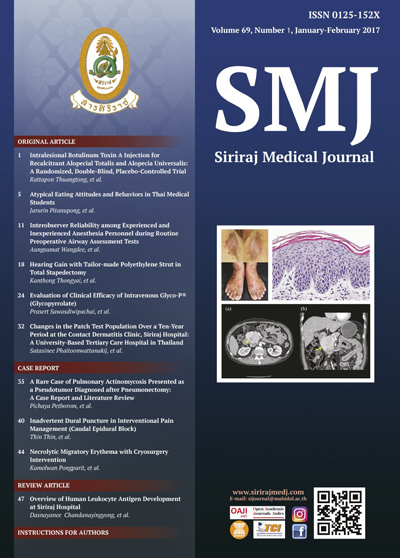Necrolytic Migratory Erythema with Cryosurgery Intervention
Keywords:
Cryosurgery, glucagonoma, necrolytic migratory erythemaAbstract
Necrolytic migratory erythema (NME) is a rare skin condition, which is the first presenting manifestation in almost 70% of the patients with glucagonoma. It is characterized by well-defined scaly erythematous patches with crusted erosion in annular appearance. The predominant areas are genital area, intertrigenous sites and lower extremities. This article has presented the case who had a 5-month history of progressive erythematous scaling patches with crusted erosion on acral, trunk and intertriginous areas. He had been treated for several months at another hospital without definite diagnosis. Our investigations revealed diabetes mellitus and a 6.5x5.7x6.0 cm mass at pancreatic head without liver metastasis. Percutaneous biopsy revealed monomorphic round cells with pleomorphic nuclei which immunohistochemical staining which revealed strongly positive for neuroendocrine tumor. The diagnosis of probable glucagonoma associated with NME was established. Zinc supplement was initiated resulting in marked improvement of his rash. He went to Fuda Hospital in China to receive cryosurgery for his pancreatic tumor. Up until now, there has been no recurrence of his rash and his general condition remains stable for 3 years. However, CT scan at 3 years after cryosurgery showed slight increase in size of pancreatic mass and increased degree of diffuse dilatation of main pancreatic duct and side-branch. Thus, long term follow-up is mandatory to conclude the outcome of cryosurgery for pancreatic cancer.
Downloads
Published
How to Cite
Issue
Section
License
Authors who publish with this journal agree to the following conditions:
Copyright Transfer
In submitting a manuscript, the authors acknowledge that the work will become the copyrighted property of Siriraj Medical Journal upon publication.
License
Articles are licensed under a Creative Commons Attribution-NonCommercial-NoDerivatives 4.0 International License (CC BY-NC-ND 4.0). This license allows for the sharing of the work for non-commercial purposes with proper attribution to the authors and the journal. However, it does not permit modifications or the creation of derivative works.
Sharing and Access
Authors are encouraged to share their article on their personal or institutional websites and through other non-commercial platforms. Doing so can increase readership and citations.










